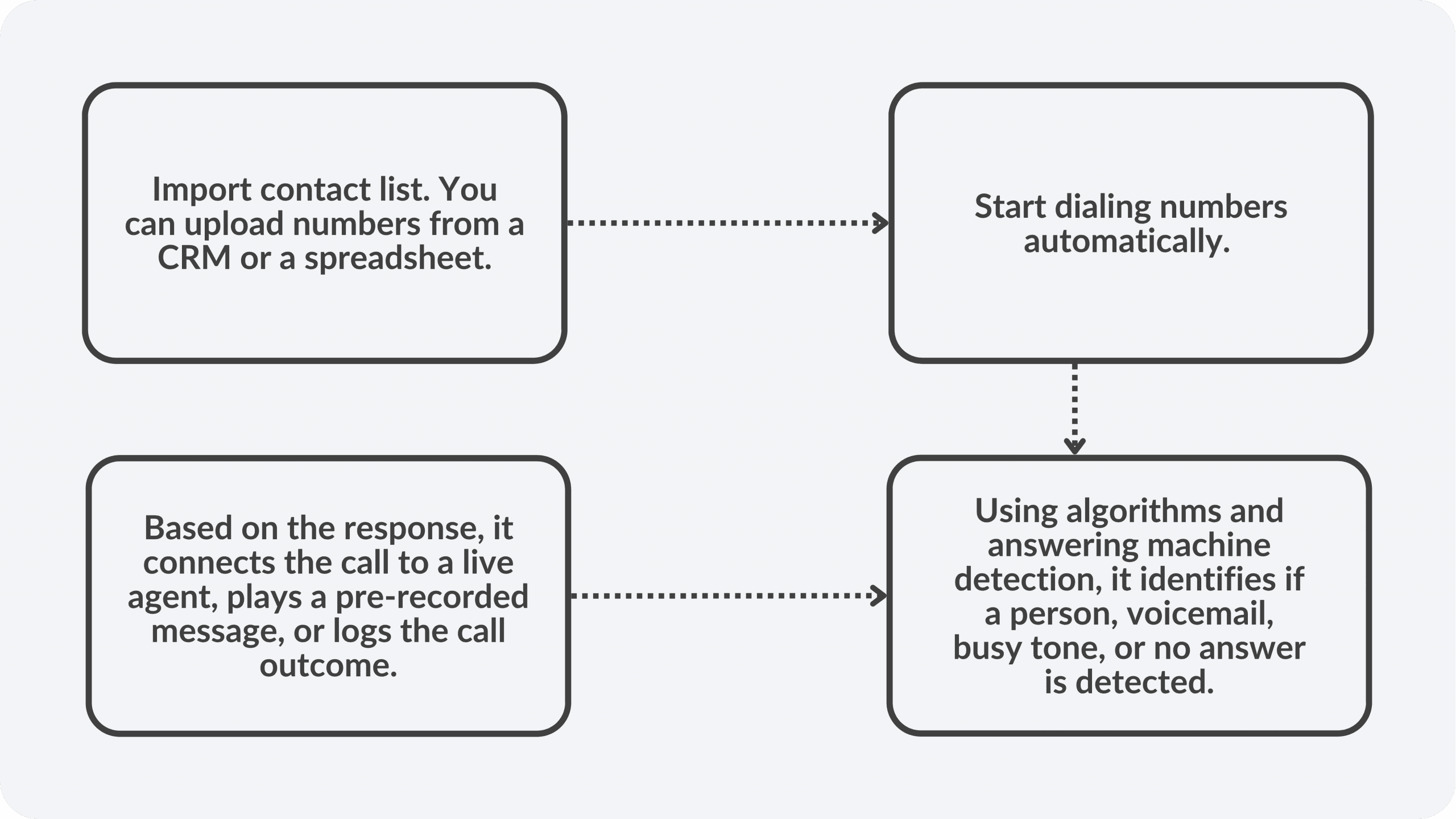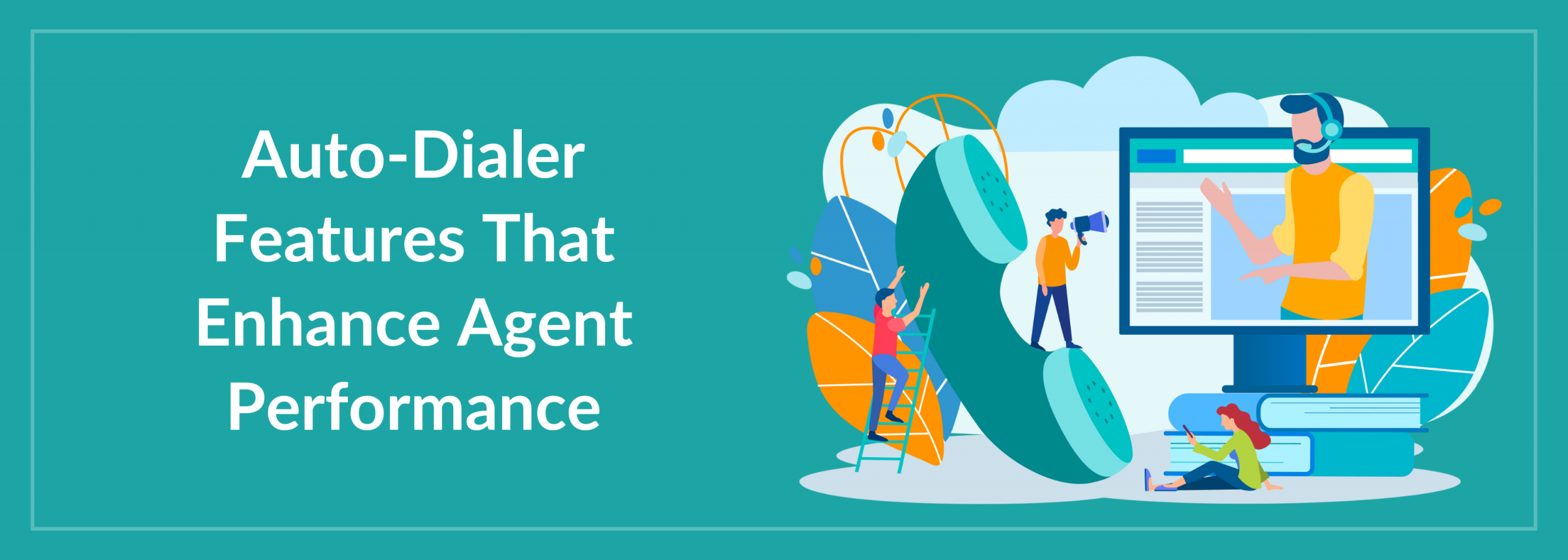10 Must-Have Auto-Dialer Features That Enhance Agent Performance
For decades, outbound contact centers have been caught in a strange paradox.
Agents are busier than ever, but customers are harder to reach than ever.
They spend hours clicking numbers, waiting through busy tones, or leaving voicemails only to have connect rates that make every campaign feel like a slog.
And yet, leaders still measure success by how many calls an agent makes per day.
The truth is, agent performance isn’t about call volume; it’s about connection quality and conversion momentum.
Would an auto-dialer help here?
A good auto-dialer solution doesn’t just speed up calling; it orchestrates it. It brings in efficiency, compliance, automation, empathy, creativity, and real-time intelligence.
But not all auto-dialers are created equal. The difference between an average dialer and a world-class one lies in the features that help agents focus on what they do best: engaging humans.
How an Auto Dialer Works?

10 Essential Features Every Auto Dialer Should Have
These features are designed to boost agent performance, backed by real contact center use cases.
1. Smart Dialing Models: Predictive, Progressive, and Preview
Do you have the flexibility to use multiple dialer models? Various models of auto-dialing exist, and here they are:
Predictive dialers: A predictive dialer software use algorithms to dial multiple numbers in advance and assign connected calls to available agents.
Progressive dialers: Automatically dial the next number only when the agent is available.
Preview dialers: In a preview dialer software agents see the contact information before the call and choose when to dial.
A debt-collection customer of ours ran multiple campaigns to send reminders and pursue settlements. They used predictive dialing for reminders and preview dialing for settlements.
This allowed their agents to handle settlement discussions with empathy and accuracy.
2. Advanced Call-List Management and Segmentation
Do your agents waste a lot of time scrolling through spreadsheets or dealing with duplicate leads?
Does your auto-dialer support built-in list segmentation and rule-based filtering?
An insurance customer of ours segmented their call lists by renewal date, policy value, and language preference.
The dialer automatically prioritized policies that were soon to expire and routed them to agents with the right skills to handle the renewals.
This would allow you to increase the conversion rates and improve the agent’s morale.
3. Real-Time Call Monitoring and Whisper Coaching
Have you ever thought of performance as continuous learning instead of just metrics?
Do your supervisors listen in on your calls and discreetly guide you without the customer hearing?
One of our loan aggregator customers found that their agents struggled to handle objections during a personal loan campaign.
Immediately, their supervisors and team leads used whisper coaching to prompt responses that helped them handle the objections.
This mentoring helped the agents improve their conversion rate by 30%.
Real-time coaching shortens the learning curve and builds agent confidence.
4. CRM and Helpdesk Integration
How many of your calls are data-driven?
How many of your interactions are logged automatically?
Are your dialers integrated with your CRM and helpdesk systems?
A fintech customer integrated its dialer with Salesforce and Zendesk. With this integration, the customer’s agents could instantly access customer history, open tickets, and view pending actions as soon as the call connected. Besides, it helped them sync post-call notes back into the CRM and helpdesk systems.
Your agents would save a lot of time by avoiding manual updates, while reducing errors and delivering more personalized experiences.
5. Dynamic Call Routing and Skill-Based Assignment
Does your dialer support intelligent routing? Does it do so using skill sets, time zones, availability, and language proficiency?
A healthcare BPO customer used intelligent routing to ensure their customers received the best possible experience. They routed all insurance verification calls to trained specialists, while general queries were routed to entry-level agents.
This helped them minimize transfers and improve first-contact resolutions.
6. Local Presence and Number Masking
How likely are you to answer calls from familiar area codes?
When you see a local number on your caller ID, you’re more likely to pick up the call.
Does your dialer automatically support local presence dialing?
A national mortgage company ran campaigns across multiple states. When calling Texas, they always used numbers with a 512 or 214 prefix.
Answer rates jumped by 25% without compromising compliance.
Tweaks like number localization can dramatically boost connect rates, allowing agents to have more live conversations.
7. Compliance Management
Do your dialers comply with standards and regulations like TCPA, GDPR, and DNC lists?
A global collections customer ran campaigns in North America and Europe. Our auto-dialer automatically screened numbers on DNC lists, throttled call frequency, and redacted sensitive information from call recordings to comply with privacy laws.
As an agent, you don’t have to worry about rule breaches, and instead, you can focus on customer conversations.
8. Omnichannel Callback and Voicemail Drop
When customers don’t pick up, what does your dialer do?
Does it automatically leave a personalized voicemail, or send a text or WhatsApp message?
A retail customer ran a loyalty renewal campaign. They used voicemail drops for customers who did not pick up the call and followed up with a text containing a renewal link.
This resulted in a 20% increase in renewals.
Why should your outbound conversations end when the call goes unanswered? You should ensure continuity with voice and text messages while offering the customers the flexibility to respond at their convenience.
9. Call Disposition, Notes, and Automated Follow-up
What do you do after a call, as an agent?
You need to mark outcomes as interested, not reachable, call back later, and trigger next steps.
Does your dialer have an intuitive call-disposition system that auto-schedules callbacks or follow-up messages, keeping pipelines warm without manual effort?
We have a B2B sales customer. Whenever an agent tags a lead as ‘proposal sent’ in the CRM, the dialer automatically schedules a callback reminder for three days later.
Besides, it sends a notification to the account executive on their preferred messaging app.
You don’t have to worry about any leads falling through the cracks.
10. AI-Driven Analytics and Performance Insights
What do you do with data without any insights?
Does your dialer provide you with insights? Does it have dashboards that talk beyond call counts and call duration?
Does it highlight connection quality, talk-to-listen ratios, sentiment scores, and burnout indicator?
A collections customer used our voice analytics solution to detect agents who spoke 80% of the time and listened only 20%.
With this knowledge, they coached those agents to balance conversations, which led to higher payment commitments and better empathy scores.
Read our blog on : How Auto-Dialers Help Boost Call Center Efficiency
Rethinking ROI: Why Smart Dialers Deliver More Than Just Speed
When evaluating dialers, many leaders still ask:
How much faster can my agents call?
The better question is:
How much better can my agents connect?
ROI is measured in:
- Higher right-party contacts
- Better first-call resolutions
- Reduced average handling times
- Improved agent morale and retention
Each of the 10 features above measurably contributes to that equation.
We’ve come a long way from the days when auto-dialers were just call accelerators. Today, they’ve quietly turned into something smarter that continuously learns.
They don’t just make agents dial faster; they help them dial better. They listen, adapt, and take the grind out of the process so that every second counts, not because the call volume went up, but because every conversation now means more.
But here’s the catch.
Technology is only as good as the experience it delivers. A dialer that connects faster but leaves agents frustrated isn’t progress; it’s just chaos at scale.
And if automation can’t make sense of the noise, it’s just more noise.
You will have to make speed, intelligence, and empathy work together. That’s the point where technology stops being just another tool on the desk, and it starts acting like a teammate that’s got your back.
And really, that’s where we’re headed.
Dialers shouldn’t just help agents make more calls; they should help them make meaningful ones. Because when you think about it, performance isn’t about chasing call counts; it’s about creating conversations that actually go somewhere.
